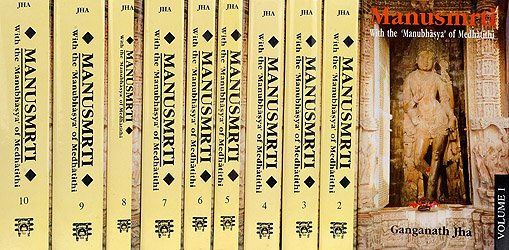Manusmriti with the Commentary of Medhatithi
by Ganganatha Jha | 1920 | 1,381,940 words | ISBN-10: 8120811550 | ISBN-13: 9788120811553
This is the English translation of the Manusmriti, which is a collection of Sanskrit verses dealing with ‘Dharma’, a collective name for human purpose, their duties and the law. Various topics will be dealt with, but this volume of the series includes 12 discourses (adhyaya). The commentary on this text by Medhatithi elaborately explains various t...
Verse 8.74
Sanskrit text, Unicode transliteration and English translation by Ganganath Jha:
समक्षदर्शनात् साक्ष्यं श्रवणाच्चैव सिध्यति ।
तत्र सत्यं ब्रुवन् साक्षी धर्मार्थाभ्यां न हीयते ॥ ७४ ॥samakṣadarśanāt sākṣyaṃ śravaṇāccaiva sidhyati |
tatra satyaṃ bruvan sākṣī dharmārthābhyāṃ na hīyate || 74 ||Evidence based upon what is directly seen and is heard is admissible; and a witness, telling the truth in such cases, does not fall off from spiritual merit or worldly prosperity.—(74)
Medhātithi’s commentary (manubhāṣya):
“It has already been said (under 69) that evidence may be given by any person who may be ‘cognisant of the facts of the case’; why then should any inadmissibility be suspected, in view of which it is now said that evidence on the basis of what is seen and heard is admissible?”
Our answer is as follows:—It has been said that the witness shall be warned by the person who he is going to file his suit, saying—‘you shall be my witness’; so that people might think that if a person has not been so warned, he shall be inadmissible; it is in view of this that the present declaration has been made. The meaning is that if a person happens to be close by when a certain transaction is being gone through and is cognisant of the facts, he is admissible as a witness, even though ho may not have been warned by the parties, saying ‘you will please bear in mind this transaction between us.’
The term ‘directly’ has to be construed with ‘what, is seen’ as also with ‘what is heard’; so that if some one bears of a fact from one person, and from the former some one else hears it, then the person who has heard of it at second hand is not admissible as a witness; as it is only on hearsay, and not on the basis of any direct source of knowledge, that the man would know that ‘this man has committed such and such a crime,’ or that ‘he owes such and such a sum to that man.’
‘What is directly seen’—means direct knowledge of the facts of the case, bearing upon loan-transactions, assaults and so forth; i.e., when these occurrences are actually wen with the eye; or ‘directly heard’ in the case of verbal assaults,—such as ‘I shall take away your wife,’ and so forth,—and such admissions by the debtor as that ‘I have borrowed such and such a sum from that man,’ and so forth.
Though the root ‘dṛśi,’ ‘to see,’ denotes all forms of apprehension (and as such includes auditory perception also), yet ‘what is heard’ has been mentioned separately for the purpose of filling up the metro. All that is meant is that ‘a person who has a right knowledge of the facts is admissible as a witness’; and the phrase ‘what is seen’ is meant to stand for all valid kinds of knowledge; so that what is known by inference is also regarded as ‘known’; similarly also all trustworthy Revelation, which is an authoritative means of knowledge in regard to imperceptible things also.
The second half of the verse is merely re-iterative, the telling of truth having been already enjoined before, and the fact of the liar losing both spiritual merit and worldly prosperity being already known from other sources of know ledge.—(74)
Explanatory notes by Ganganath Jha
This verse is quoted in Vyavahāratattva (p. 26);—in Kṛtyakalpataru (27a), which says that ‘samakṣadarśana’ and ‘śravaṇa’ stand for all forms of valid knowledge, hence the meaning is that that man is a witness who possesses a right knowledge of the subject-matter of the enquiry;—and in Vīramitrodaya (Vyavahāra, 44b).
Comparative notes by various authors
Bodhāyana (1.19.7).—‘In order to gain the good opinion of men, a witness shall give evidence in accordance with what he has seen or heard.’
Viṣṇu (8.13-14).—‘The evidence of witnesses is of two kinds—what was seen and what was heard. Witnesses are free from blame if they give true evidence.’
Nārada (1.148).—‘He should he considered as a witness who has witnessed a deed with his own ears or eyes; with his ears, if he has heard another man speaking; with his eyes, if he has seen something himself.’
Bṛhaspati (7.8-13).—‘That witness is denominated a messenger who is a respectable man, esteemed and appointed by both parties, and has come near them to listen to the speeches of the plaintiff and the defendant. He is a spontaneous witness who declares that he has witnessed the transaction, after having approached the court of his own accord, while a cause is being heard. That witness who communicates to another man what he has heard, at a time when he is about to go abroad, or is lying on his death-bed, should he considered as an indirect witness. He also is called an indirect witness who repeats, from his own hearing or from hearsay, the previous statements of actual witnesses. He is called a secret witness to whom an affair has been entrusted or communicated by both parties, or who happens to witness the transaction. The King himself, having heard the statements of both the Plaintiff and the Defendant, may act as a witness.’
